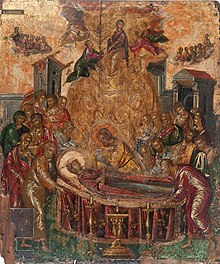Cretan school

The Cretan School is an important school of sacred painting, especially icon painting , which brought Byzantine art to a late bloom during the Venetian rule over Crete from the 15th to the 17th century .
Historical and cultural background
After the fall of Constantinople in 1453, Byzantine artists and scholars began an exodus from the now Ottoman- ruled city into the rulership of Venice . She was particularly attracted by Crete, which as Regno di Candia formed a Christian island in the eastern Mediterranean and became the center of art in the Greek world.

Crete was an important center of icon painting. As a Venetian area, it had a natural market advantage to meet the strong demand for Byzantine icons in Europe, so it soon dominated supply.
An early example is the famous icon of the Virgin Mary in Sant'Alfonso in Rome , known as Our Lady of Perpetual Help , which was very well known in Rome. At that time, there were hardly any stylistic differences between Cretan and other Byzantine icons.
A considerable number of wall paintings in churches and monasteries also fell during this period. A total of around 850 frescoes from the 14th and 15th centuries have been preserved on Crete, far more than from earlier or later periods.
The lively cultural exchange between Italy and Crete led to a strong mutual influence and cultural fertilization. Just as the Greek language was taught and classical texts were read in Italy, the artists of the tradition of Byzantine painting in Crete adopted aspects of the painting style and in particular the painting technique and method of representation from Renaissance Italy and merged them with the Byzantine tradition. Italian painters such as Titian and Veronese exerted a strong fascination on many Greek artists.
In the heyday of the Cretan school, there were more than 100 icon painters working for Orthodox, Catholic and private clients. The training center was the Katharinenkirche in Heraklion, where theologians and lawyers were trained and which functioned as a university.
After the Ottoman occupation of Crete in the 17th century, the center of Greek painting shifted to the Ionian Islands , which remained under Venetian rule until 1797. With the painting school of the Ionian Islands, a new art movement arose there , which was predominantly influenced by western artistic currents.
Stylistic characteristics
Towards the end of the 15th century, however, Cretan artists had developed a style of icon painting that adopted the forms and contents of the Western representation. It is through richer colors, a more human, more emotional representation of the figures depicted, through care in detail, precise contours, plasticity, depth of space and perspective , the modeling of the flesh with a dark brown primer and small highlights on the cheeks, bright colors in the clothes, geometric The folds and the balanced structure of the composition are marked. Sometimes the representation remains strongly dominated by the strict orthodox canon of forms, sometimes it turns strongly towards a naturalistic style.
Well-known representatives
Mikhail Damaskinos
Michail Damaskinos was the most important representative of the Cretan school of the time. In 1574, at the invitation of the Greek community, he went to Venice to paint the icons of the church of San Giorgio dei Greci . In Italy he was fascinated by the Venetian style of painting. After a few years in Corfu , he returned to Crete, where he had a workshop in Candia .
El Greco
Dominikos Theotokopoulos, who became famous in Spain as El Greco (the Greek), is the most famous painter to emerge from the Cretan school. He was the most successful of the many artists who tried a career in Western Europe. El Greco, however, left the Byzantine style far behind in his later career.
Angelos Akontatos
Angelos Akotantos , who until recently was still considered a conservative painter of the 17th century, is today, after the discovery of a will from 1436, regarded as an innovative artist who lived until around 1457 and combined Byzantine and Western stylistic elements. His students Angelos Bizamanos and Nicholas Tzafuris (until 1501) also became important artists.
Theophanes the Cretan
Known as Theophanes the Cretan Theophanes Strelitzas ( Greek Θεοφάνης Στρελίτζας Theofanis Strelitsas , approx. 1500–1559) was a Greek monk. He was trained as an icon painter in Heraklion , but was not active in Crete, but mainly on the Greek mainland and is considered the most important Greek fresco painter of his time. His frescoes show some western iconographic and stylistic elements, but remain largely in the Byzantine style.
Other painters of the Cretan School
- Georgios Klontzas
- Ioannis Kornaros
- Emmanuel Lombardos
- Ilios Moskos
- Theodoros Poulakis (Θεόδωρος Πουλάκης, 1622–1692)
- Philotheos Skouphos
- Emmanuel Tzanes (Εμμανουήλ Τζάνες, 1610–1690)
- Viktor
literature
- From Byzantium to El Greco. Byzantine Museum of Arts, Athens 1987.
- Manolis Chatzidakis, in: The Icon , 1982, Evans Brothers Ltd, London 1981, ISBN 0-237-45645-1 .
Web links
- H Kρητική Σχωλή ζωγραφικής The Cretan Painting School Special supplement of the Kathimerini (Greek) (PDF; 4.0 MB)
- Irini Krimizaki, Κρητική Σχολή και Μεταβυζαντινή Ζωγραφική Cretan School and Post- Byzantine Painting (Greek)
- National Gallery of Athens
- Nano Chatzidakis: Velimezi's icon collection
- Passion scenes, icon by Giorgios Klontzas in Philadelphia, The Walters Art Museum
Individual evidence
- ↑ Manolis Chatzidakis, in: From Byzanz to El Greco , Museum of Byzantine Art, Athens 1987, p. 42
- ↑ Erica wishes: ADAC travel guide Crete: Hotels. Restaurants. Museums. Ancient sites , p. 15
- ↑ Manolis Chatzidakis, in: The Icon , 1982, Evans Brothers Ltd, London 1981, ISBN 0-237-45645-1 , pp. 311-312


